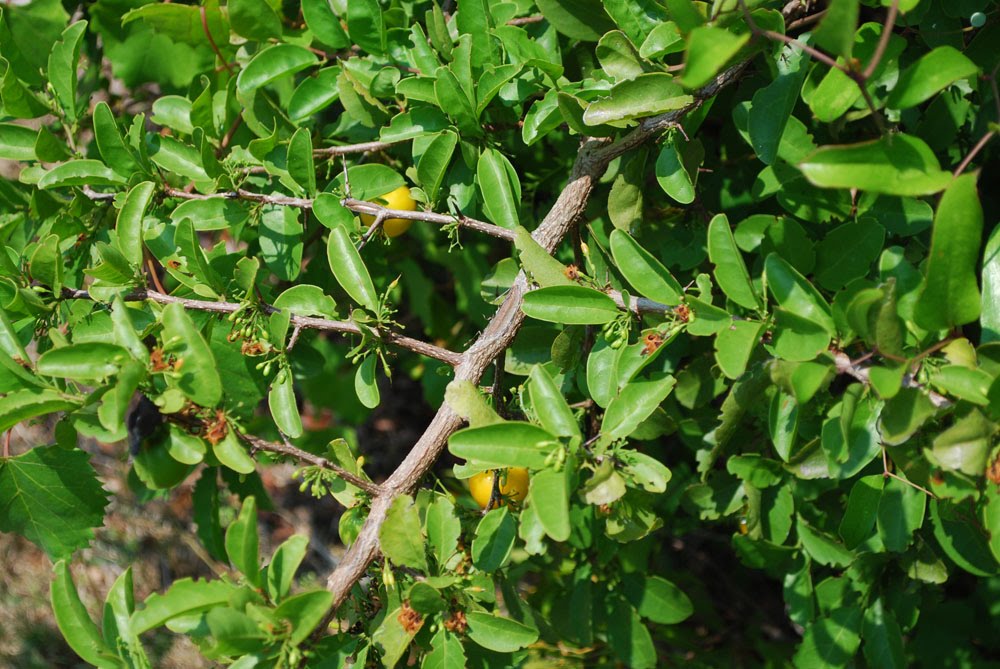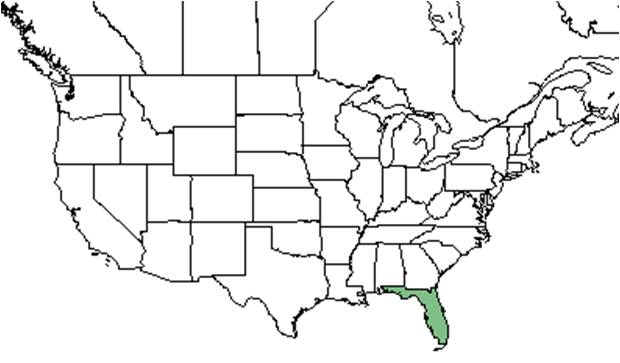Difference between revisions of "Ximenia americana"
(→Cultivation and restoration) |
|||
| Line 26: | Line 26: | ||
==Ecology== | ==Ecology== | ||
===Habitat=== <!--Natural communities, human disturbed habitats, topography, hydrology, soils, light, fire regime requirements for removal of competition, etc.--> | ===Habitat=== <!--Natural communities, human disturbed habitats, topography, hydrology, soils, light, fire regime requirements for removal of competition, etc.--> | ||
| − | In the Coastal Plain in Florida, ''X. americana'' has occurred in coastal scrubs, palmetto-oak hammocks, longleaf pine- | + | In the Coastal Plain in Florida, ''X. americana'' has occurred in coastal scrubs, palmetto-oak hammocks, longleaf pine-hickory-oak woods, sand pine scrubs, limestone in palm-cedar hammocks, live oak hammocks, longleaf pine-wiregrass communities, and coastal marine hammocks (FSU Herbarium). Associated species include ''Liatris laevigata, L. ohlingerae, Tillandsia utriculata, Pinus palustris, Serenoa repens, Quercus geminata, Q. myritfolia, Q. chapmanii, Stillingia, Aristida, Certiola'', ''Carya floridana'', and ''Pinus clausa'' (FSU Herbarium). |
===Phenology=== <!--Timing off flowering, fruiting, seed dispersal, and environmental triggers. Cite PanFlora website if appropriate: http://www.gilnelson.com/PanFlora/ --> | ===Phenology=== <!--Timing off flowering, fruiting, seed dispersal, and environmental triggers. Cite PanFlora website if appropriate: http://www.gilnelson.com/PanFlora/ --> | ||
Revision as of 15:18, 22 March 2016
| Ximenia americana | |
|---|---|

| |
| Photo by Wayne Matchett, SpaceCoastWildflowers.com | |
| Scientific classification | |
| Kingdom: | Plantae |
| Division: | Magnoliophyta - Flowering plants |
| Class: | Magnoliopsida – Dicotyledons |
| Order: | Santalales |
| Family: | Olacaceae |
| Genus: | Ximenia |
| Species: | X. americana |
| Binomial name | |
| Ximenia americana L. | |

| |
| Natural range of Ximenia americana from USDA NRCS Plants Database. | |
Common names: tallow wood, yellow plum
Contents
Taxonomic notes
Description
Distribution
Ecology
Habitat
In the Coastal Plain in Florida, X. americana has occurred in coastal scrubs, palmetto-oak hammocks, longleaf pine-hickory-oak woods, sand pine scrubs, limestone in palm-cedar hammocks, live oak hammocks, longleaf pine-wiregrass communities, and coastal marine hammocks (FSU Herbarium). Associated species include Liatris laevigata, L. ohlingerae, Tillandsia utriculata, Pinus palustris, Serenoa repens, Quercus geminata, Q. myritfolia, Q. chapmanii, Stillingia, Aristida, Certiola, Carya floridana, and Pinus clausa (FSU Herbarium).
Phenology
Flowers March through November and fruits January, June through August (FSU Herbarium).
Seed dispersal
Seed bank and germination
Fire ecology
Pollination
The following Hymenoptera families and species were observed visiting flowers of Ximenia americana at Archbold Biological Station (Deyrup 2015):
Apidae: Apis mellifera, Mellisodes communis
Halictidae: Agapostemon splendens, Augochloropsis sumptuosa, Lasioglossum placidensis
Megachilidae: Coelioxys germana, Megachile mendica
Sphecidae: Bicyrtes quadrifasciata, Eremnophila aureonotata, Isodontia exornata
Vespidae: Mischocyttarus cubensis, Pachodynerus erynnis, Parancistrocerus perennis anacardivora, Zethus spinipes
Use by animals
Diseases and parasites
Conservation and Management
Cultivation and restoration
X. americana is a medicinal plant known for its antioxidant properties. Traditional medicinal practice for X. americana was used to treat malaria, fever, leprotic ulcers, and skin infections. In northern Nigeria, X. americana has been used to treat fever, stiffness, onchocerciasis, sore throat, asthma, and bad headaches. The roots are used to treat abdominal pains, dysentery, inflamed joints, and mouth ulcers. The leaves of X. americana contain cyanogenic glycosides, flavonoids and tannins, which are also common in many other plants [1]. A study conducted by Kibuge (2015) used X. americana to be a plant species considered for biofuel and it ultimately qualifies as a potential biofuel. X. americana’s seed oils were mixed with kerosene (a fossil fuel) to see if it reduced the cost of biofuel. Overall, the study found out that kerosene is still the best fuel to burn for energy and for the use inside home. The study recommends to further research the X. americana seed oil to determine the burning rate, flame height, and smoke gases for the fuel to be used indoors for lighting and cooking [2].
Photo Gallery
References and notes
Deyrup, M.A. and N.D. 2015. Database of observations of Hymenoptera visitations to flowers of plants on Archbold Biological Station, Florida, USA.
Florida State University Robert K. Godfrey Herbarium database. URL: http://herbarium.bio.fsu.edu. Last accessed: November 2015. Collectors: Loran C. Anderson, Jane Brockmann, Robert K. Godfrey, Robert Kral, O. Lakela, Robert J. Lemiare, S.W. Leonard, Sidney McDaniel, T. Myint, Mary E. Nolan, Jackie Patman, James D. Ray Jr., Cecil R. Slaughter, Earl Smith Jr., R. Smith, D.B. Ward. States and Counties: Florida: Brevard, Collier, Flagler, Highlands, Indian River, Levy, Monroe, Osceola, Palm Beach, Pinellas, Sarasota. Compiled by Tall Timbers Research Station and Land Conservancy.
- ↑ Maikai, V.A., Kobo, P.I., and Maikai, B.V.O. (2010). “Antioxidant properties of Ximenia americana.” African Journal of Biotechnology Vol. 9(45): 7744-7746.
- ↑ Kibuge, R.M., S.T. Kariuki, and M.R. Njue (2015). “Influence of fuel properties on the burning characterisitcs of sour plum (Ximenia americana L.) seed oil compared with Jatropha curcas L. seed oil.” Renewable Energy 78: 128-131.